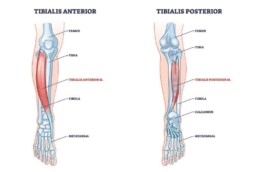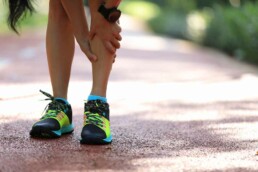While you may think of splints as devices used to immobilize injured body parts, it’s a term that has another connotation in the medical world, one with which many runners are all too familiar. Shin splints is a term used to describe pain in the lower leg; it refers to the inflammation of one of the muscles that runs along the tibia or shin bone, the tibialis posterior. The tibialis posterior runs along the inside rear of the tibia bone. Posterior shin splints are the most common cause of painful shin bones.
The Mechanics Behind The Pain
Your tibialis posterior muscle controls a portion of the foot’s arch when it is doing weight-bearing exercise. It helps to produce the motion that allows your foot to lift off the ground when you are running or walking, necessary to keeping the foot and ankle stable; this is called supination. The tibialis posterior muscle also helps to apply the brakes to the flattening of the arch when you are in motion.

What Causes Shin Splints?
Posterior shin splints can be result from various causes, including:
- Flat feet – Flat feet can put too much stress on the tibialis posterior muscle and tendon by causing the muscle to be lengthened. If the foot’s core muscles aren’t strengthened, the foot may be subject to over-pronate and there may be an inward knee collapse, which aggravates shin splints.
- Overuse or overtraining – If you increase your mileage on the roads, you are landing on your foot more often, which increases the force on your arches. If you run faster, you increase the force with which you strike the ground, which can also have a negative impact on your tibialis posterior muscle.
- Tight calf muscles – If your calves are tight, your ankle’s range of motion becomes limited, causing pronation that causes your tibialis posterior to work too hard.
- Weak hip and core muscles – These muscles help control the leg’s inward rotation, and if the pronation becomes more extreme, it can aggravate your tibialis posterior muscle.
- Worn out footwear – Walking or running shoes help support the feet and ankles, so if a shoe begins to break down, the foot may pronate more and require the tibialis posterior to work harder, which can lead to inflammation.
Symptoms of Posterior Shin Splints
- Dull, aching pain in the inside-rear front of the lower leg;
- Shin pain along the side of the tibia bone or within associated muscles; or
- An area that is tender to the touch.
However, you should talk to a registered physiotherapist or a physician before proceeding with specific treatment options. A physiotherapist will base the treatment on the severity of the injury.
With stage one shin splints, your pain disappears during warm up exercise, so you may be allowed to continue exercising unless the injury worsens. A stage two injury means the pain may reappear at the end of a workout, so your physiotherapist may recommend modified workouts while you are treated.
If shin pain worsens during a workout, this means that it’s time to suspend activity before the tibia suffers stress fractures. This is a stage three injury. If you have pain and discomfort all the time, your injury has progressed to stage four and it’s time to stop all activity. You may need crutches or an air cast to take pressure off the area while it heals.
It’s important to address shin splints even though the recovery isn’t quick; it usually takes at least two months. However, depending on the severity of the injury, you may be able to continue with modified exercise.

Diagnosis and Treatment
As with most injuries, it’s useful to start with the RICE method of treatment: rest, ice, compression and elevation. Apply ice every two to four hours for 20 to 30 minutes. Avoid anti-inflammatory drugs for the first 48 to 72 hours. See your physiotherapist as soon as possible to obtain a diagnosis so that you can begin to rehabilitate your injury. Initially, your physiotherapist may do some supportive taping to help support the injured soft tissue and offer your tibia some stress reduction.
Next, your physiotherapist will work with you to help you regain your full range of motion without pain. This often involves remoulding scar tissue so it doesn’t tear easily in the future by lengthening and orienting it through stretching, massage and targeted exercises. Your physiotherapist will also evaluate your gait to determine what corrections need to be made so that you can prevent a recurrence of your shin splints. You may need to wear corrective orthotics to give your foot some assistance.
Restoring strength to your muscles is also critical, so your physiotherapist will help you create a realistic exercise plan that will restore weakened calf, shin, quadriceps, gluteal and other lower limb muscles to their appropriate strength. Once you’ve reached this point, it’s time to return to your usual activities – but you’ll want to work with your physiotherapist to create a workable re-entry plan.
So, if you’re feeling pain in the area near your tibia, don’t hesitate to have it diagnosed. As they say, shin up – or do I mean chin up?!
